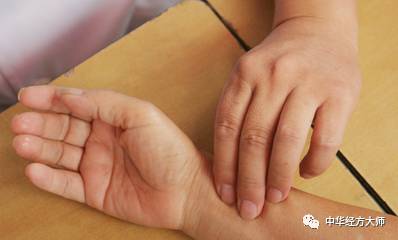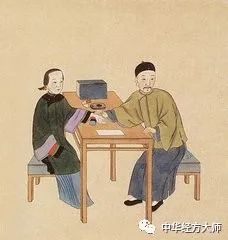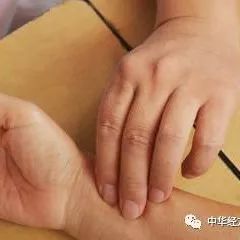
When it comes to diagnosis, it is often said to be pulse taking (切脉, qiè mài), but in fact, diagnosis is not limited to pulse taking; it also includes examining the skin, the sides of the body, the area below the heart, and the upper and lower abdomen. The term “切” (qiè) implies closeness, as in “切身” (qiè shēn, close to the body) or “亲切” (qīn qiè, intimate), which means using one’s hands to closely examine the patient’s body to diagnose diseases. Nowadays, many doctors focus solely on pulse taking and neglect other diagnostic methods.
In the treatment of diseases, Zhang Zhongjing (仲景, Zhòngjǐng) emphasized not only pulse taking but also the examination of the chest, sides, and abdomen, as extensively described in the “Shang Han Lun” (《伤寒论》). When a patient comes for diagnosis, after a brief greeting to understand the basic situation, pulse taking follows. Before taking the pulse, one can use their hands to feel the temperature of the skin on the forearm; if there is fever, part of the condition can be known beforehand, which is the first step of diagnosis.
Especially for diagnosing fever in children, besides using a thermometer or feeling the skin, I prefer to use my lips to sense the temperature, as kissing the child provides a more intimate feeling. The sensitivity of the lips is beyond that of the hands; feeling the forehead with the lips is much more effective than using the hands. A person’s body temperature is not fixed and can vary; sometimes thermometers can be misleading. Asking the mother about the child’s mouth temperature while breastfeeding can provide first-hand information about whether there is a fever, when it occurs during the day, and any patterns.
When inquiring about sweating, it is generally the first question to ask. This is easy to clarify in adults, but more difficult in children. One can use their palm to feel the front and back of the chest; the dryness or moisture of the skin is quite clear, which can determine the presence of sweat. If the skin is moist, although it indicates sweating, medication should be used appropriately. These are small actions, yet they are essential skills for diagnosis.
For examining the chest, sides, and abdomen, the patient should first be positioned correctly, lying flat on the examination table with their legs bent, relaxing their mind and not resisting the doctor.
Let’s first discuss the “Chai Hu” (柴胡, Chái Hú) syndrome of “chest and side fullness”; this is the patient’s self-perception. If there is “hardness under the ribs” (胁下痞硬, xié xià pǐ yìng), the patient may not be able to articulate it clearly. By pressing under the ribs and on the sides of the abdomen, one can lightly feel for fullness or, upon pressing harder, feel resistance. At this point, the patient may frown or express slight pain; “urgent feeling under the heart” (心下急, xīn xià jí), “hardness under the heart” (心下痞硬, xīn xià pǐ yìng), and “pain upon pressing under the heart” (按之心下满痛, àn zhī xīn xià mǎn tòng) indicate hardness and resistance upon pressure, with varying degrees of severity. The distinctions of Chai Hu syndrome can be discerned.
For phlegm and fluid accumulation in the chest and sides, besides the patient’s self-reported feelings of fullness or pain with breathing, the doctor can also diagnose by pressing upwards on the area below the heart and the stomach, which may induce chest and side pain and a feeling of suffocation. This is known as “hardness and fullness under the heart, leading to pain under the ribs”.
The symptoms under the heart, the term “痞” (pǐ) indicates blockage. Although it differs from “结胸” (jié xiōng, chest obstruction) in that it is “not approachable”, the “hardness under the heart” (心下痞硬, xīn xià pǐ yìng) is contrasted with “hard fullness and pain” (结胸硬满而痛, jié xiōng yìng mǎn ér tòng). By assessing the hardness and pain upon pressure, one can understand the severity and nature of the disease, leaving no hidden details.
“Abdominal fullness with pain” (腹满时痛, fù mǎn shí tòng) that prefers warmth and pressure indicates deficiency, with the disease in the Taiyin (太阴, Tàiyīn) channel; “great fullness and pain” (大实痛, dà shí tòng) that resists pressure indicates excess, with the disease in the Yangming (阳明, Yángmíng) channel. The choice of medication can be considered based on whether to relieve pain or purge.
The temperature of the abdominal skin, as well as the tension and relaxation of the abdominal muscles, can often be felt during diagnosis. The main goal of abdominal examination is to understand the temperature, softness, hardness, lumps, and tenderness of the abdomen.
For instance, feeling the abdominal skin for temperature can help differentiate between cold and heat syndromes. If the skin is not warm or cold, it indicates a cold syndrome; if the patient prefers warmth, it indicates a deficiency cold syndrome; if the skin is very hot and feels burning, it indicates a heat syndrome; if the patient prefers cold objects, it indicates a real heat syndrome. If pressing causes burning, it indicates internal heat; if the abdominal wall is soft upon light pressure but firm upon heavy pressure, it is mostly a normal state.
If the abdominal wall is thin and feels soft and weak upon pressure, it indicates a deficiency syndrome; if the abdominal wall feels hard, it indicates an excess syndrome.
If the abdomen is distended and feels full upon pressure, with tenderness and a heavy, muddy sound upon percussion, it indicates an excess syndrome; if it feels empty upon pressure, with no tenderness, and produces a hollow sound like a drum upon percussion, it indicates a deficiency syndrome.
If pressing on the abdomen causes pain, especially if the patient resists pressure, it indicates an excess syndrome.
If pressing causes pain that is fixed and unchanging, with persistent stabbing pain, it indicates blood stasis; if the pain is variable, with distension that comes and goes, it indicates qi stagnation.
When examining the abdomen for lumps, attention must be paid to their size, shape, hardness, tenderness, and whether the surface is smooth. Abdominal lumps that are painful indicate accumulation. If the lump is fixed and painful upon pressure, it indicates a chronic disease related to blood; if the lump is variable and painless upon pressure, it indicates a gathering syndrome related to qi.
Using percussion to vibrate the organs is also a method of diagnosis, such as in suspected urinary stones. Small stones may not be visible on ultrasound. If the urinary tract is not ruptured, blood cells may not be visible under a microscope, and some may not cause urinary irritation. Except for the obvious pain from kidney stones, abdominal pain from stones in the ureter can often be confused with acute appendicitis or gynecological acute abdomen. I often tap the kidney on the affected side; if the pain in the abdomen worsens upon vibration, I can confirm the diagnosis.
In gynecology, special attention must be paid to diagnosis; if relying solely on the patient’s complaints without abdominal examination, the condition is often difficult to clarify. The examination of the uterus and adnexa differs.

When palpating the lower abdomen, one first assesses the fullness of the uterus; a full and distended uterus often indicates excess, while a soft and small uterus often indicates deficiency. If the patient feels pain upon pressure, and the pain lessens or is preferred upon pressure, it indicates deficiency; if the pain worsens or is resisted upon pressure, it indicates excess. The examination of the adnexa is located in the lower abdomen, where any masses or pain can be assessed.
Zhang Zhongjing’s three treatises on women’s diseases primarily discuss cold syndromes and excess conditions, as “women’s diseases are due to deficiency, accumulation of cold, and qi stagnation, leading to obstruction of the meridians and cessation of menstruation, resulting in years of blood cold accumulation, cold injury to the uterus, and hardened meridians…” This summarizes the essence of the conditions.
By examining the skin for heat, one can discern between exterior and interior conditions, and by examining the chest and abdomen, one can explore yin and yang as well as deficiency and excess.
The knowledge gained by the doctor through personal examination is intuitive, while the knowledge obtained through cold machines is mechanical and can only serve as an auxiliary. Nowadays, relying entirely on medical auxiliary examinations to understand diseases has become a bad habit, leading to a decline in diagnostic skills among doctors, and even suggesting that diagnostic skills have disappeared, which is very dangerous.

